There has been a lot of breast-beating in the press and in the blogosphere about how economists failed to discern the possibility that not all was going well in the years leading up the current financial and economic crisis [1]. I think the notion that all economists were blithely optimistic has been dispelled (well, okay, here’s a couple of exceptions: Dan Gross h/t Free Exchange, A. Kaletsky). At the risk of some gross simplifications, I will speculate that there was —
until recently — less optimism among academic macroeconomists than Wall Street economists. There was probably less anxiety among
say finance professors who focused on asset pricing (as opposed those who worked in banking) than macroeconomists (Dani Rodrik highlights the diversity). One divide that
I think is not particularly relevant in locating the source of the crisis is the most well known one — specifically whether prices
are sticky.
In my opinion, the big divide in thinking relates to how economists conceive of financial markets working. This is a divide that cuts across other divides. For instance, the Hicksian
decomposition (IS-LM), in its simplest incarnation, treats the financial world as one wherein bonds are identical, and the only means of borrowing; there is no separate channel for lending, say via bank loans, to influence aggregate demand (see this post for the many channels of monetary policy). In the real business cycle literature, and many New Keynesian DSGE models, there is a representative bond (and lending rate) which summarizes the asset markets (see Camilo Tovar’s survey of DSGEs for a discussion).
I think these types of models — both New Keynesian and RBC — are useful for thinking about many aspects of macroeconomic behavior. In fact, typically, the models I work with in my academic research on for instance exchange rates incorporate such assumptions. However, in thinking about the causes of the current financial and economic crisis, and the appropriate policy response, it seems to me it is essential to utilize models that either incorporate, or allow for, the lending channel via the financial system to be important. In other words, models that do not have some sort of financial accelerator and role for banks are likely to provide highly misleading policy conclusions (so the debate is
not “merely academic”).
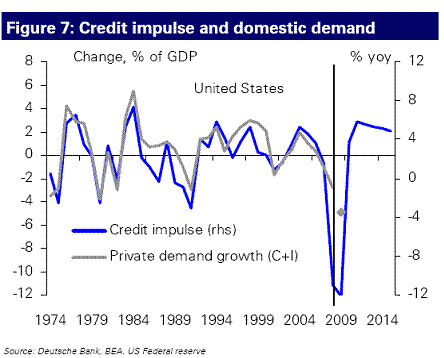
Figure 7 from M. Biggs & T. Mayer, “Credit impulse: Lessons from the Great Depression,” Deutsche Bank Global Macro Issues, 13 March 2009 [not online]. Credit Impulse = (ΔCt/GDPt)-(ΔCt-1/GDPt-1). See M. Biggs, “The impact of credit on growth,” Deutsche Bank Global Macro Issues, 19 Nov 2008 [not online]
Who’s been thinking about these sort of issues? In one of his recent columns, David Warsh mentions the work of Geanakoplos, as if the issues of leverage and credit cycles are new. It’s true that some of Geanakoplos’s ideas are new (especially the focus on leverage), but the theoretical modeling of how borrowing in the presence of agency issues has been around for a long time. This assertion can be easily verified by consulting the reference list in this (recent) review in the 2007
NBER Macro Annual, essentially a set of notes by Kiminori Matsuyama, “Aggregate Implications of Credit Market Imperfections”. This point validates Dani Rodrik‘s point about how many economists saw impending trouble: “Bob Shiller, Nouriel Roubini, Raghu Rajan”. To this list, I’d add George Akerlof, who foresaw in his 1993 Brookings paper with Paul Romer, the “looting” that would occur as regulations were relaxed in environment of pervasive asymmetric information (as I discussed in this April 2007 post).
How can one incorporate the idea of the importance of the banking system (separate from its importance to the money creation process)? One very simple static model is provided by a twenty year old paper by Bernanke and Blinder.
Loan demand and loan supply:
Ld = L(ρ, i, y)
∂L/∂ρ < 0, ∂L/∂i > 0, ∂L/∂y > 0
Ls = λ(ρ,i, Z)D(1-τ)
∂λ/∂ρ > 0, ∂λ/∂i < 0, ∂λ/∂Z < 0
Where ρ is the lending rate, i is the bond interest rate, y is income, τ is the reserve/deposit ratio, Z is the riskiness of the marginal investment project.
LM curve:
D(i,y)=mR
∂D/∂i < 0, ∂D/∂y > 0
Where D(.) is deposits, m is the money multipier and R is reserves.
Commodity-Credit (CC) curve [composite IS and credit equilibrium]:
y=Y(i,ρ)
∂Y/∂i < 0, ∂Y/∂ρ < 0
To solve for equilibrium, set loan demand equal to loan supply, after substituting the LM in for D:
L(ρ,i,y) = λ(ρ,i,Z)mR(1- τ)
Without knowing the parametric form of the functions, one can’t solve out analytically for ρ, but one knows in the end that:
ρ = φ (i, y, R, Z )
Substituting this solution for ρ into the expression for the revised IS curve incorporating a role for ρ and taking a total differential leads to the solution for dY:
dY = (1/Δ){[((Yρρi+Yi))m/Di
)+YρρR]dR + YρρZdZ}
Where Δ ≡ [1-YρρY+((Yρρi+Yi)DY)/Di]
and Yρ is ∂Y/∂ρ, and so forth.
So, the change in income is, given the posited parameter values, a positive function of R and m, and a negative function
of Z. More math and context here [pdf]. Some of these effects are summarized in Table 1.
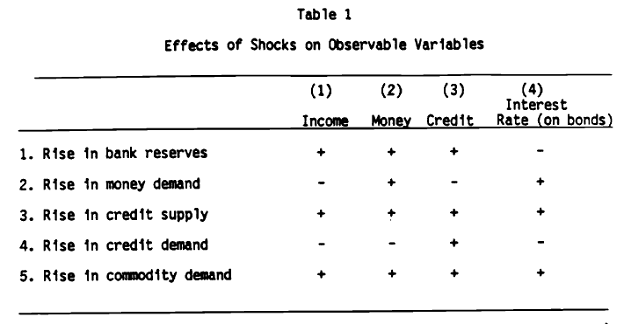
Table 1 from Bernanke and Blinder.
I like to think in terms of graphs. Below I show how the CC and LM curves are shifted in due to increases in risk (Z going up), if the money multiplier falls (m declines).
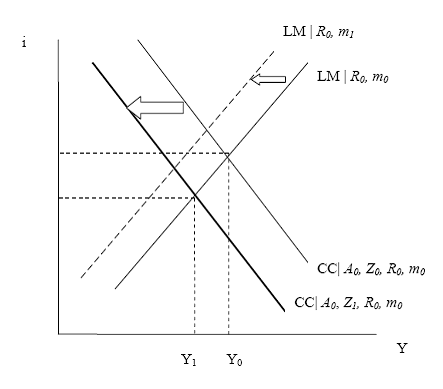
Figure 1: Shifts due to increase in project risk (Z rises) and decrease in money multiplier (m declines) (white arrows).
An increase in reserves (or somehow decreasing excess reserves so m rises) will shift out both the CC and LM curves, as shown in Figure 2.
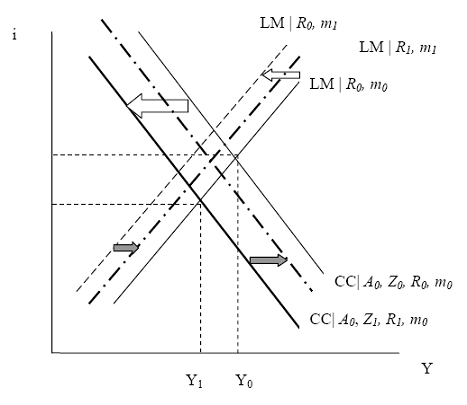
Figure 2: Shifts due to increase in project risk (Z rises) and decrease in money multiplier (m declines) (gray arrows).
This type of analysis also highlights how monetary policy can affect both the LM and CC curves; it also illustrates why fixing the banking sector is so important (increasing D increases
lending).
The financial accelerator is not explicit in this interpretation, but it could be introduced in the following fashion. If Z is
not exogenous, but depends on the level of income — so that declines in income raise Z, and vice versa, then a positive (in a technical sense) feedback loop can be introduced.
This modification would then illustrate why stimulating the economy (increasing GDP relative to what it otherwise would be) is important to fixing the banking sector. If the CC curve is shifted out, and Z depends upon the level of output, then the CC curve will be shifted out even further out, as shown in Figure 3.
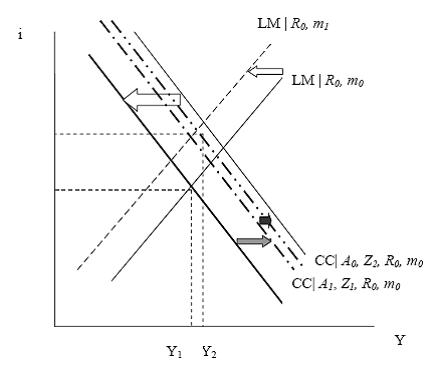
Figure 3: Holding monetary policy constant, increase government spending (gray arrow). Additional shift if Z is endogenous to output level (black arrow).
The foregoing has been a static, extremely ad hoc, discussion. I’ve eschewed sophistication in favor of working in a framework that is somewhat familiar to those who’ve worked with IS-LM. For those who want a more sophisticated, dynamic, interpretation, see Chapter 21 of the Handbook of Macroeconomics, “The financial accelerator in a quantitative business cycle framework,”, by Ben S. Bernanke, Mark Gertler and Simon Gilchrist.
A logical conclusion from the foregoing discussion is that there were indeed many people who were concerned about the apparent buildup of financial sector imbalances. And these economists were typically not those steeped in the macro literature which assumed smoothly working (neoclassical) financial markets. They were the ones concerned with how some markets are not continuously cleared by the Walrasian auctioneer.
Hence, as we consider how to get out of this mess, we should pay more attention to the economists who warned of trouble, than those who viewed the economy as running smoothly (e.g.). So I’ll finish off by quoting from Akerlof and Shiller’s Animal Spirits (p.96):
…Standard macro models are fairly accurate regarding the monetary-fiscal stimulus necessary to achieve full employment. But financial markets must also be targeted. The financial system is not the same as it was just a few months ago, before the fall of Humpty Dumpty. Only a portion of its prior self is now operating. The aggregate demand target will indicate, on the one hand, the fiscal stimulus and interest rate policy needed for full employment. The credit target wil show what judicious application of methods 1, 2 and 3 [discount window, direct injections of capital, direct credit from GSEs] must achieve: together they must create the financial flows — the issuance of commercial paper, bonds, and other instruments — that are also associated with full employment.
Menzie,
I think you overlook some valid criticism of macroeconomists. The issue is not, “did some macroeconomists have valid models.” It is, “were most macroeconomists blinded by their reliance on invalid models.”
Recently you wrote that, despite the “changed world we live in”, you hoped that an empirical analysis relying on the last twenty years of data would yield conclusions about the future. Why hope? Why not challenge, probe, ask the question, “where is the model wrong given what we know today?”
I’m amused by macroeconomists that say their models were right but could not incorporate such things as a decline in housing standards. This is like saying, “I’m powerless to use logic where empirical analysis is impossible.” The decline in standards, and its attendant effects, were hiding in plain sight. And yet most continued to conclude that “house prices never decline on a national basis in nominal terms” without questioning the conclusion.
So its not about some models being better than others. Its about freeing yourself from regression models and using logic to pose questions — the relevant questions, not the immaterial ones. Those that got this right posed the question: what is the systemic risk created by the “great moderation” and chronically low Fed policy rates? Everyone of their observations and conclusions followed from that question, and not from the resulting elegance of their empirical analysis.
How are those climate models coming along?
David,
Excellent post!!
…steeped in the macro literature which assumed smoothly working (neoclassical) financial markets.
Menzie,
I’m not sure I understand what this means. Can you expand a little?
Investment needs to operate at the most important term points in the natural yield curve. The natural yield curve changes substantially upon an unexpected shift in the consumer model. The new consumption model does not initially have enough market presence to yield smooth estimates. Parts of the investment system is thus absent, waiting for stronger signals. Actually this process applies to all sectors.
In particular, the long deflationary spiral results when government itself is restricting the consumption signals by out of sync management of some critical resources. It is then that we get underground activity, until government revenue is so small that the constrained resource is obvious.
“How are those climate models coming along?”
What on earth does that have to do with IS/LM?
Bizarre posting.
OK, there were 4 economists who saw the problems coming, and were vocal about the dangers in advance. Several other professions are heavy users of applied math and logic – like accounting, engineering, statistics, etc. In those professions, when a risky scenario is presented, thousands of practitioners can comment consistently on the nature of the risk. These professions have models that have been validated against data repeatedly and are consistently used by the practitioners. Economics has a challenge in the nature of experiments, but validation against data is possible. It is this contrast with economics that has captured a lot of people’s attention. We count on economists for advice on really important matters like our personal income and investment results. It turns out economics is more like alchemy, where theories abound, many practitioners get the right answer occasionally, and it depends a lot on who you listen to and what questions they have been recently researching. So that’s where we are. The question is what will economists do about their profession, rather than which small number of folks got it right this time.
David Pearson: I’m not certain we disagree. If your point is that many economists were blinded by the reliance on invalid models, sure I’ll agree with that.
When I said “I hoped”, that didn’t mean I was just going to raise my hands and shrug. In fact, I’m sure I’ll be running the relevant regressions very soon. It’s that I don’t believe the world is so changed that all previously identified empirical relationships disappear (for instance, some form of Okun’s Law will still likely hold).
Anonymous: Well, at its most basic level, that the set of Arrow-Debreu securities span all states; see this set of notes for a concise description. At a more pedestrian, specific, level, I like to think about situations where some markets are credit rationed due to asymmetric information.
Mike Laird: I think it’s disengenuous of you to say there were only 4 economists who warned about the dangers of where the world economy was going. Maybe my set of acquaintances is unrepresentative, but I think a lot of economists were worried and saw trouble coming. I’ll count myself as one, but one who did not worry sufficiently about the derivatives issue (I worried about net indebtedeness, not gross indebtedness). I will admit that the reception to my worries was fairly dismissive, as you may recall if you read the comments to some of my 2005 posts (e.g.)– but I’m not certain those comments were mostly be economists. By the way, at the time, I wrote, in response to commenter USD: “Not all net worth is created equal. How much of net wealth is in the form of housing valuations, which might be more ephemeral (this time around) than other assets? And I didn’t pluck this idea out of thin air — consumers appear to spend different proportions of wealth, depending upon type, with the variation depending upon the “persistence” of the form of wealth….
In any event, the United States is becoming more indebted with respect to the rest of the world, at a pretty fast clip (net foreign debt to GDP didn’t rise last year due to valuation effects, but this year, watch out since the dollar hasn’t depreciated).”
Love the math models! As if nirvana could be found by algorithm, then we would all be rich and there would never be any economic issues. Great work though.
Mike, the evidence of this crisis is that economic models cannot, in fact, be validated by the data. All of financial industry models were validated against historical data, which led directly to the crisis.
Empirical analysis will not capture key potential changes in FX and interest rates. That is because a country risk “premium” has never existed for the U.S. dollar, at least not in the period studied. This premium arises from concerns over the trajectory of structural budget deficits: when they reach a tipping point, the lower the economic growth forecast, the higher the deficit trajectory, the more the possibility of aggressive and permanent Central Bank monetization, the higher the probability of devaluation. This dynamic typically causes the sovereign bond spread (over comparable bonds) to be inversely correlated with the exchange rate. The more devaluation, the higher the sovereign bond premium. In the case of competitive devaluations, it may be the case that all sovereign bond rates rise and the devaluation occurs against real goods.
In short, the empirical analysis will leave out the “tail risk” of a major change in the relationships, and yet it is this “tail risk” that should be the very subject of study. In much the same way, macroeconomic models excluded the “tail risk” of nominal house price declines, when that was, for obvious reasons, the very subject they should have focused on. This is what I mean when I say “blinded by models”: when they leave the important bit out, they are worse than useless, they are dangerous.
If you looked at the Case-Shiller index in 2005, you knew there was a housing bubble.
What was less clear to me (until I ran the analysis this past week) was the degree to which the consumer–via mortgages and consumer credit of various sorts–was becoming indebted. But the Fed should have been amply aware. Yet no one protested, no one resigned, there is no ‘Union of Concerned Economists’.
Why was that? Perhaps this is how weak public institutions are today. I am astounded that, to this day, government officials still have not addressed what seem to me to be the critical difficiencies in the system (as seen, quite literally, from Wall Street). I am not really sure they have the tools to do so.
I would add that economists tend to be weak in understanding accounting, and that would have been critical in understanding the impact of declining housing values on financial institutions. The financial statements of virtually every affected institution are public, and the disclosures (10-Q’s, 10-K’s) are often quite revealing.
The other possibility, of course, is that economists just didn’t think it was that big a deal, which would suggest we are making more of the recession than it deserves, perhaps.
A strange amnesia has set in regarding the pre-2007 debates. There was a substantial minority of economists (among whom I count myself) who publicly feared a hard landing due to unsustainable global imbalances. This is exactly what has happened, with two caveats. First, what precipitated the landing was not a breakdown in “currency recycling” (capital account inflows to the US), but “credit recycling” (the mechanisms, particularly equity extraction from housing, by which these inflows made their way to households so they could sustain consumption beyond their so-called budget constraints). In other words, instead of a dollar crash, we had an asset crash. (There is some evidence for the same process in other countries with sustained current account deficits, e.g. the UK and Spain.) The dollar continues to do fine under the perception that it provides shelter from the storm, but this is not likely to continue forever. A run on the dollar, as Buiter warns against, is a real risk and would be catastrophic under current conditions.
The second caveat is the one brought up by Menzie: those of us speculating on hard crashes considered only the net, not the gross exposures of the financial system. As a result, we missed the ferocity with which deleveraging would take hold. The last year has given us quite an education.
I’m sure different economists participating in the minority view I’ve described came to it on the basis of, or in some instances despite, very different theoretical priors. My own route was strongly influenced by the financial balances framework promulgated by Wynne Godley at the Levy Institute, although I think his accounting perspective could use more behavioral development. But mainstream new Keynesians and others were arriving at similar conclusions.
Menzie: I am not disingenuous. I simply counted the number of economists that you mentioned in your posting – it was 4, with no comment “that there might be others”. You (conveniently) miss my point that most economists have been blind-sided by events, even though it is their business to analyze trends, forces, and events just like the ones that have unfolded over the past few years. Yes, reactions were pretty dismissive a year ago. I received the same dismissive comments in my own circles, and on this blog site. In fact, it seems I still get dismissive comments that are off my topic. It is proof of my point. If a large, multi-year, risky data collection project was presented to a bunch of statisticians, most of them would recognize the risk and describe it in consistent terms. As a profession, they recognize models that work. That does not happen in economics. Some economists still think Greenspan did a wonderful job.
Walt: It is common to say models failed, and many did. Some models have been terrific, profitable performers. I know some myself. George Soros made $1 billion this past year. I would venture it was not by guesses and seat of pants. He has some good models – I believe. Just remember – there is nothing more powerful than a good theory.
Mike Laird: I wonder if you’d find this description of the stances of sundry economists amusing. It appeared March 31, 2008:
David Pearson: Why would you make a distinction between models and logic? What makes economics a valuable (even when it is wrong) discipline, is its rigorous use of mathematical models to make its logic explicit. Without this rigor, it would be hard to know when the logic is unsound. So freeing ourselves from models will not help the profession make progress. Unlike other disciplines, we don’t have controlled experiments to more efficiently test our models/logic. So it is not suprising that we are wrong more often than physics or engineering. But now we have a new set of experiences (data) and our prior investments in modelling will allow us to more efficiently update our logic.
Mark,
The problem with pointing to the underlying logic of models is that it is constrained: as used widely by economists, models carry the directive of: if you can’t prove it (with a regression), don’t think it. Constrain logic at the outset, and you get garbage conclusions. Here’s an example from the bubble:
To those of us claiming there was a housing bubble, econometricians (aka economists) responded that their models prove nominal house prices never fall, so why worry? Also, we were told unemployment drove mortgage defaults. The latter was a tautology: no recession, no unemployment, no housing crisis, no recession.
These econometricians refused to ask the question, “how could I be wrong?” If they used rigorous logic, they would have realized that, taken to its conclusion, the “nominal prices never fall” axiom meant that no level of mortgage leverage could cause an increase in house price volatility; and, no level of lax underwriting could drive defaults in the absence of unemployment. Conclusion: the bubble could go on forever. Obviously, this was a failure of logic rooted in an over-reliance on empiricism. How could you view it any other way?
Any peer reviewer should ask the question, “what potential relationship has this economist left out simply because it cannot be modeled with the available data set.” It seems a reasonable request, and yet it might revolutionize economics as practiced today. Imagine, one would look to economic history or thought experiments to come up with the answer to the question.
I think the more precise way to state the problem with econometrics is this: most such work is calibration of models that need to be taken on faith. At most, what we get is “the evidence is consistent with…”, but this tells us very little about whether we should believe any particular model. True minimization of type I error (which is necessary for any science to advance over time) requires not merely statistical protocols like high significance levels or appropriate estimators, but also, and especially, the design of critical tests that isolate a single model from all other alternatives. Yes, this is difficult to do in economics, but it is even more difficult if you are not trying to do it in the first place. One hint I’d offer to modelers is this: while there are few opportunities to conduct such tests on outcome data (e.g. natural experiments), there are more at the level of mechanisms and processes. In fact, this is how most sciences that study complex systems (e.g. biology) operate.
Economics as it is currently practiced has no built in impetus for discarding false theories.
David Pearson: I’m not sure I understand. First, econometricians = economists? I count myself an econometrician, although not a very high tech one, and I ask these sort of questions of myself all the time. And having lived in California in the early 1990s, I would have never said that housing prices never fall. Exactly who are these econometricians you’re speaking of? Not Case or Shiller (see BPEA, 2003, e.g.)
Just remember to tell your grandchildren to be extremely thorough when evaluating high yield securities after 2084. Assuming you remember, would they listen? It appears individuals of all strata apply a hyperbolic discount model to historical data… by the time the advice reaches maturity it is gauged antique and irrelevant.